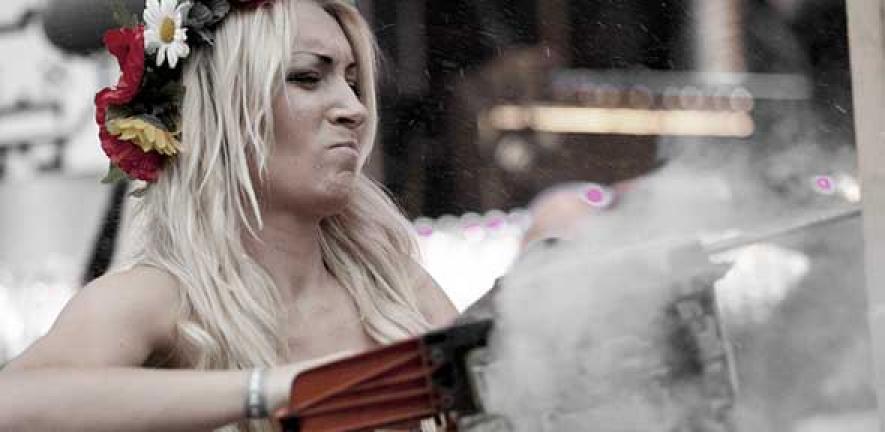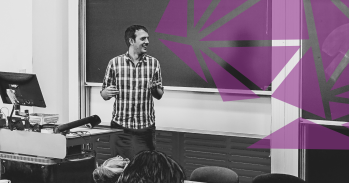
When radical feminists took their cause from Europe to North Africa, the outcome was a deepening of the divides they sought to break down. Social anthropology student Raffaella Taylor-Seymour argues for greater reflection about the meaning of freedom.
When radical feminists took their cause from Europe to North Africa, the outcome was a deepening of the divides they sought to break down. Social anthropology student Raffaella Taylor-Seymour argues for greater reflection about the meaning of freedom.
When it comes to advocacy, protest and many kinds of charitable action, the start must be a long hard look in the mirror.
Raffaella Taylor-Seymour
Earlier this year the radical feminist group Femen turned its attentions away from Europe to North Africa, targeting vast swathes of the Arab and Muslim world with its uncompromising messages. Up until this point the protestors, who dub themselves as “sextremist”, had focused their activities on Europe and primarily on issues affecting white European women.
Emerging in the Ukraine around five years ago, Femen made its name with its own brand of attention-grabbing publicity. Images of its topless protests, nipples blurred, appeared in media throughout the world and, to some extent, conformed to passively-held assumptions of what “radical feminism” might look like. In other words, it knowingly plays up to feminist stereotypes in the quest for publicity.
Femen argues that the female body can re-assert itself, and the meaning attached to it, through anti-patriarchal messages scrawled on bare breasts. The group seeks to challenge norms by inverting the hyper-sexualised signal that exposed breasts typically send. Whether you believe in its value or not, this mode of protest plays out in the real world as a dangerous strategy. The political message is often lost, indeed undermined, by the same widespread salacious interest in the naked female body that garners Femen so much media coverage.
Given the flurry of sensationalised media surrounding Femen’s nude protests, it’s not surprising that many feminists have distanced themselves from the group, arguing that its tactics reinforces the notion that women can only get attention for (and by means of) their physicality, not on the strength of the inherent merit of the feminist cause.
The catalyst for the shift in Femen’s focus was Amina Tyler, 19-year-old founder of the group’s Tunisian branch. In March this year Amina posted topless photos of herself on Femen’s Facebook page. One image, in the style that has become characteristic of Femen’s activism, depicts Amina with the slogan “My body belongs to me and is not the source of anyone’s honor” written in Arabic across her bare chest. Another shows her with “F**k your morals” in the same bold style.
These images triggered immediate reactions within Tunisia, with Amina reportedly receiving threats of death by stoning. Rumours circulated that she had been arrested by the local authorities; these turned out to be false. Femen’s rapid response was the organisation of “Topless Jihad Day” in support of Amina – and what began as feminist activism quickly slipped into what appeared to be anti-Muslim protest.
It became apparent that Femen is waging a campaign that shows little consideration for the vast majority of the community whose rights it claims to promote. The group that spoke up against Femen, Muslim Women Against Femen, sought to challenge the narrative that Muslim women are de facto oppressed by dressing a certain way or subscribing to a particular theology.
As many other commentators have noted, Femen have obvious representation issues outside Europe. White European women represent the vast majority of its supporters and, furthermore, they seem committed to advancing a particular brand of feminism as universal with little regard for local histories and efforts.
Many observers too baulked at the language of “Topless Jihad Day”. Jihad is not a word to be used lightly. One can only imagine how frustrating it must be for Muslims, who regularly insist that jihad is misunderstood by both terrorists and Western commentators, to have it thrown back at them in this effectively hollow sense. It seemed another instance of Femen prioritising attention-grabbing publicity over coherent message. But beyond this, seeking to “save” others implies superiority.
The Femen protests are more than simply unnecessarily provocative and culturally insensitive: they also expose deeper truths. In response to Femen, Muslim Women Against Femen instituted “Muslimah Pride Day”. The group described Femen as perpetuating and promoting Islamaphobia and accused it of cultural imperialism. Many individual voice spoke about issues of freedom and choice. One post displayed the message: “My hijab is my pride. Islam is my freedom. This is my choice. I don’t need you to be my voice. I have mine.” Another one tackled feminism head-on: “Feminism comes in many forms! You bare up, I cover up.”
The manager of Muslim Women Against Femen’s Facebook page regularly warns members against “slut shaming” Femen activists. Hundreds of responses illustrate complex, multi-faceted responses to Femen’s actions, not outright rejection. The message is clear: freedom has to involve choice, and respect for the choices of others. The posts engage with feminist debates, while exposing how such protests ultimately struggle to engage with multiple forms of oppression. Two of the many messages that illustrate this are: “Nudity does not liberate me and I do not need saving” and “Let me tell YOU how oppressive your culture is.”
The issue with Femen’s representation is not just that white, European women are campaigning on ‘behalf of’ Muslim women. By its actions, Femen (perhaps unintentionally) deepened racial and religious divisions within the communities it sought to liberate. These tensions led to the alienation of many women who came to see themselves as having no place within the Western feminist movement, which they now associate with Femen’s radical protests.
Worse still, Femen, in the eyes of many Muslim and Arab women, has come to symbolise oppression. While attempting to liberate Muslim women, Femen has succeeded in oppressing them along religious and racial lines.
Femen misrepresents the complexity of both individuals and groups. A woman’s identity is shaped by an intricate web of influences – economic, cultural, sexual and religious, to name but a few. Many would argue that feminist movements do provide space for diversity among women. The problem, in Femen’s case, was that a woman could only be “in” – and by implication only be free – if she subscribed to a particular set of values that does not sit well with the lifestyles of many communities.
Across the political spectrum struggle, there is debate about what it means to be “free”. Whichever aspect is grasped, we commonly fail to see how we are simultaneously disadvantaging freedom in another respect. Femen is an archetypal example of this common occurrence. Its alienation of those it seeks to empower does not stem from uncharitability; indeed, often it comes from an overwhelming abundance of concern.
Femen activists mobilised in opposition of patriarchal control and the subjugation of women they perceived in North Africa. Many of these activists were horrified to find so many women speaking out against their campaign, and often insisted that there had been a misunderstanding.
Such a narrative ignores messy historical and political dynamics that make female empowerment different from place to place. People are products of different circumstances and choices. Can we honestly call the banning of the veil an advancement of freedom – or is it just the advancement of a particular view of what it means to be “free”? Similarly, does demonising women who choose (and also those who choose not) to wear a headscarf really liberate them? Or does it just place them in a category of “repressed”; a category that they have little power to escape without our consent.
Hardest for us to acknowledge is our own place in structures of injustice, and, at times, the place of a very particular concept of what it means to be free in those structures. While we seek to improve the lives of women by liberating them from dressing a particular way, we both willingly and unconsciously overlook that in other respects we play a role in their inequality.
A large part of this stems from our weakness at grasping multiple forms of oppression and inequality. Tunisian women are oppressed not just because they are female; this oppression intersects with poverty, religion, education, culture and other factors that may disadvantage them. It is naïve to target one aspect while refusing to see that you are simultaneously reinforcing another. Femen protests do just this; they seek to empower a group of women, and simultaneously worsen their oppression as Muslims.
When it comes to advocacy, protest and many kinds of charitable action, the start must be a long hard look in the mirror – honest self-reflection. This has to include understanding and admittance of the ways in which our position disadvantages those who we seek to help in other ways.
For the feminist movement, it is tempting to isolate sex as the crux of repression, which conveniently negates our role as wealthy (globally speaking), often white, often middle class, often Christo-agnostic, often well-educated individuals. We have to acknowledge the privilege and difference these factors endow to us, and that the women we are talking to, and often simply talking about, may also be affected by other factors, potentially to a greater degree.
We should start by working with people, with the awareness that they are as intricate, perhaps as contradictory, as we ourselves are, and that their situations are subject to personal and historical change as well. If you agree with a cause, support it – but rhetoric and ideology must flow from the repressed to the repressor. The other way around ultimately reinforces what we are seeking to overcome.
This is an edited version of an article by Raffaella Taylor-Seymour for the online magazine King’s Review. http://kingsreview.co.uk/magazine/
This work is licensed under a Creative Commons Licence. If you use this content on your site please link back to this page.





